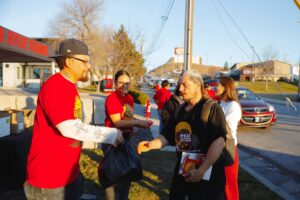
As Annie Belcourt, an associate professor in public health at the University of Montana, notes, the differences between public health in the US and in the American Indian nations first became clear to her while she was pursuing her doctoral degree in clinical psychology in the 1990s.
Belcourt, a member of the Blackfeet Nation who grew up on the reservation in Montana, writes,
As each year of school unfolded, I lost family members due to early causes of death, including homicide, suicide, motor vehicle accidents, cancer and pneumonia. I had to drive over four hours to the nearest Indian Health Service [IHS] provider for prenatal visits for my children and nearly lost one child due to lack of access to proper medical care.
The IHS, a federal agency that, like many, has faced recent threats of cutbacks, documents the gap in health outcomes. Though outcomes in some areas of American Indian health have improved—for example, infant mortality fell by two-thirds between 1974 and 2009—health disparities remain high. According to the Journal of the American Medical Association, American Indians in the 637 counties where the Indian Health Service works (and where 64 percent of all American Indians live) can expect to have a “6.4- to 8-year decrease in life expectancy compared with whites” in the same service areas. The same report found that “all-cause mortality” was 46 percent higher for American Indians than among whites.
In the state of Montana, where Belcourt lives and where American Indians make up about six percent of residents, the numbers are even more dramatic. A 2013 state public health department report found that on average, American Indians live nearly 20 fewer years than whites. According to the report, the average age at death for white men is 75 years and for white women is 82 years; in contrast, for American Indians, the average age at death for men is 56 years and for women, 62 years.
Sign up for our free newsletters
Subscribe to NPQ's newsletters to have our top stories delivered directly to your inbox.
By signing up, you agree to our privacy policy and terms of use, and to receive messages from NPQ and our partners.
The IHS has historically been inadequately funded. As Michelle Sarche and Paul Spicer, researchers at the University of Colorado–Denver, wrote in a 2009 journal article, “The IHS is so severely underfunded that it spends just $1,914 per patient per year compared with twice that amount ($3,803) that is spent on a federal prisoner in a year.” The result, as noted in a 2016 report issued by the Office of the Inspector General, is, as Belcourt writes, that “many American Indian patients receive health care that may be inadequate or of minimal quality.”
In response to federal shortfalls, American Indian communities are increasingly taking on more health equity work themselves. At the national level, leading actors include the National Council of Urban Indian Health, the National Indian Health Board, and the National Congress of American Indians. Belcourt adds, “The National Indian Health Board has a number of public health initiatives working to inform tribes on best practices in obesity, violence, suicide, and substance abuse prevention. The National Congress of American Indians advocates policies to improve health by engaging elected tribal leadership.”
At the local level, Belcourt notes, “Many tribal communities have even taken over the health care provision structure.” Measures taken including bringing back traditional healing methods, languages, and foods, and launching Native health initiatives around issues like tobacco use. “This revitalization is showing promise to improve health the entire family and community,” Belcourt says.
One example Belcourt cites is the Piegan Institute, a nonprofit that has promoted education that teaches the Blackfeet language and culture since 1987. More recently, in South Dakota, the Lakota-based Thunder Valley Community Development Corporation has developed similar programs. These efforts are important for public health, Belcourt says, because rebuilding culture is an important pathway to improving community resiliency and because tapping into indigenous healing helps address a shortfall of American Indian healthcare workers.
Some educational programs, Belcourt notes, are working to increase the number of American Indian health professionals, researchers, and educators. Belcourt herself is among the growing group of those working “in public health to help [American Indian] communities explore potential solutions to the many challenges [they] collectively face.”—Steve Dubb











